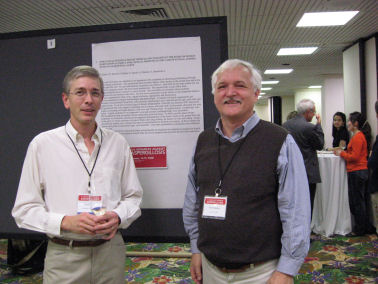|
||||||||
|
Miami, USA, March 19, 2008. A conference of medical mycologists and specialists in the area of fungal mold research of clinically relevant fungi as a mold affecting human and animal health, the Aspergilli, was attended by researchers, investigators from medicine and academic research. Prof. MJ Dumanov presented a related poster identifying clinically relevant fungi including the Aspergilli met with Dr Day (Bristol University, Langford, United Kingdom) and shared considerable interest of the parallels of human and animal disease involving the aspergilli by Dr. Michael Day from the Bristol University, Langford, United Kingdom. Abstract: In the presentation and paper by Dr. Michael Day, "Canine Sino-Nasal Aspergillosis: Parallels with human disease" a condition that is characterized by the formation of a superficial mucosal fungal plaque within the nasal cavity and/or frontal sinus of systemically healthy dogs. The most common causative agent is Aspergillus fumigatus. The fungus does not invade beneath the level of mucosal epithelium but incites a severe chronic inflammatory response that leads to local destruction of nasal bone. These clinicopathological features are equivalent to those of human chronic erosive non-invasive fungal sinusitis. The clinical diagnosis of canine SNA relies on multiple modalities but local instillation of anti-fungal agents is an effective therapy with high cure-rate. Recent studies have investigated the immunopathogenesis of canine SNA.This understanding of the immunopathogenesis of canine SNA establishes this disorder as a valuable model for the equivalent human pathology, Prof. Dumanov noted "We welcomed Dr Day's presentation and were very pleased with his findings, report and presentation. His findings have corroborated and supported our findings as indoor environmental health scientists, epidemiologists and pathologists in medical mycology. We routinely see cases of invasive Aspergillosis and commonly involving the rhino-sino-respiratory tract and also Aspergillomas as a fibrosis in the lung. In a recent Sussex county case a veterinarian's diagnosis of a canine mycosis provide a clinical lead for the physician leading to similar diagnosis of the owner." Thank you Dr Day for this highly informative presentation!
Dr. Michael J Day publications in veterinary medicine
|
